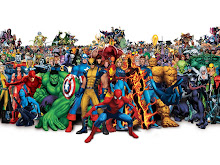The image below is of the Moviola, it was the original editing machine and was how all of the old films were put together, we have come a long way since the use of this, computers are a lot more helpful and accurate..

Another thing in the documentary that surprised me, was how sexist the industry was in the days of Verna Fields and such characters. Walter Murch said that the industry felt that editing was a more womanly job, it was like stitching, sewing or any other delicate jobs, whereas the men would be introduced when sound came into the equation because it was more of a mans job.. This made me laugh..
Listening to people like Martin Scorsese and Ridley Scott talk was really insightful, and knowing how much an editor actually did took me by surprise a little. Quentin Tarantino is just crazy, his over the top actions and the way he talks is amazing..

Interim Online Review 16/02/10
ReplyDeleteHey Matt,
I think both story ideas are still too complex - particularly the first, which, as you rightly observe, is too long, and with too much back-story to cram into your Act 1. I suggest you simply assert the existence of the robo-dog, and find the right 'frame narrative' to justify it - for instance, your 1 minute could be constructed as an advertisement or promotional video - eg.
http://www.youtube.com/watch?v=Ux3KH3q3_DE
http://www.youtube.com/watch?v=QUgxlRdX_x4
Or - you could show it development trials - with lots of gags; you know, dog shags inventor's leg... dog chases stick instead of saving guy...
see
http://www.youtube.com/watch?v=QDUlmjrWw0I
The joke could simply be 'high-tech robot! (Brain of a dog...)'
You should use the one minute format to your advantage - and not 'shrink to fit' - you can still set up the 3 acts - 'establish robo-dog' - 'Gag reel or quick-fire set-pieces' - 'Final punchiline or resolution'
Regarding your written assignment, you want to go for the film that very overtly uses editing to drive the narrative etc. see following posts for general advice re. essay.
As part of your forthcoming Animation project (Unit 5), you will be participating in a series of 2D animation workshops with Meg Bisineer – a sessional lecturer coming to us from the Royal College of Art.
ReplyDeleteMeg has asked that you equip yourselves with an ‘animator’s tool kit’. She recommends that you visit www.chromacolour.co.uk and purchase the following items BEFORE your first workshop on Friday 12th March.
Economy grade 60gsm A4 punched (1000 sheets – pre-punched) - £22.99
http://www.chromacolour.co.uk/store/animation_paper_economy.asp
3-Pin Plastic Pegbar - £2.99
http://www.chromacolour.co.uk/store/animation_pegbars.asp
The pre-punched paper and the pegbar are both necessary for the effective registration of your drawings. You will be working on your own individual A4 lightboxes – which the course is providing. Yes, it’s going to cost you some money, but the pre-punched paper and pegbar will save you a great deal of time and prep. See below for further requirements for your animator’s tool kit
1) Sketchbooks: at least A5 size or bigger.
2) Pencils: HB & 2B.
3) Eraser / Sharpeners.
4) A blue or red colour pencil.
5) A4 paper - 60 gsm (60-80 sheets)*
6) A strip of thick cardboard : 15cm x 2 cm*
7) Masking tape*
8) Paper knife*
9) Ruler*
*Note – these items are necessary if you DON’T order the specified supplies from Chromacolour – as Meg will show you a basic way to create an alternate means of registration.
In terms of paper cost – share a box with a classmate and split the costs. The weight of the paper is important (60gsm) because it is translucent, thus allowing you to see through it to your previous drawings.
Also – if you haven’t got your hands on a copy yet, you should get hold of the following
The Animator's Survival Kit : A manual of methods, principle and formulas for classical, computer, games, stop motion and internet animators: by Richard Williams, published by Faber and Faber.
The Fundamentals of Animation by Paul Wells, published by AVA Publishing.
Meg has designed a very thorough curriculum for your 4 workshops - be amazing!
Can you please circulate this information - not all your classmates are following this blog!